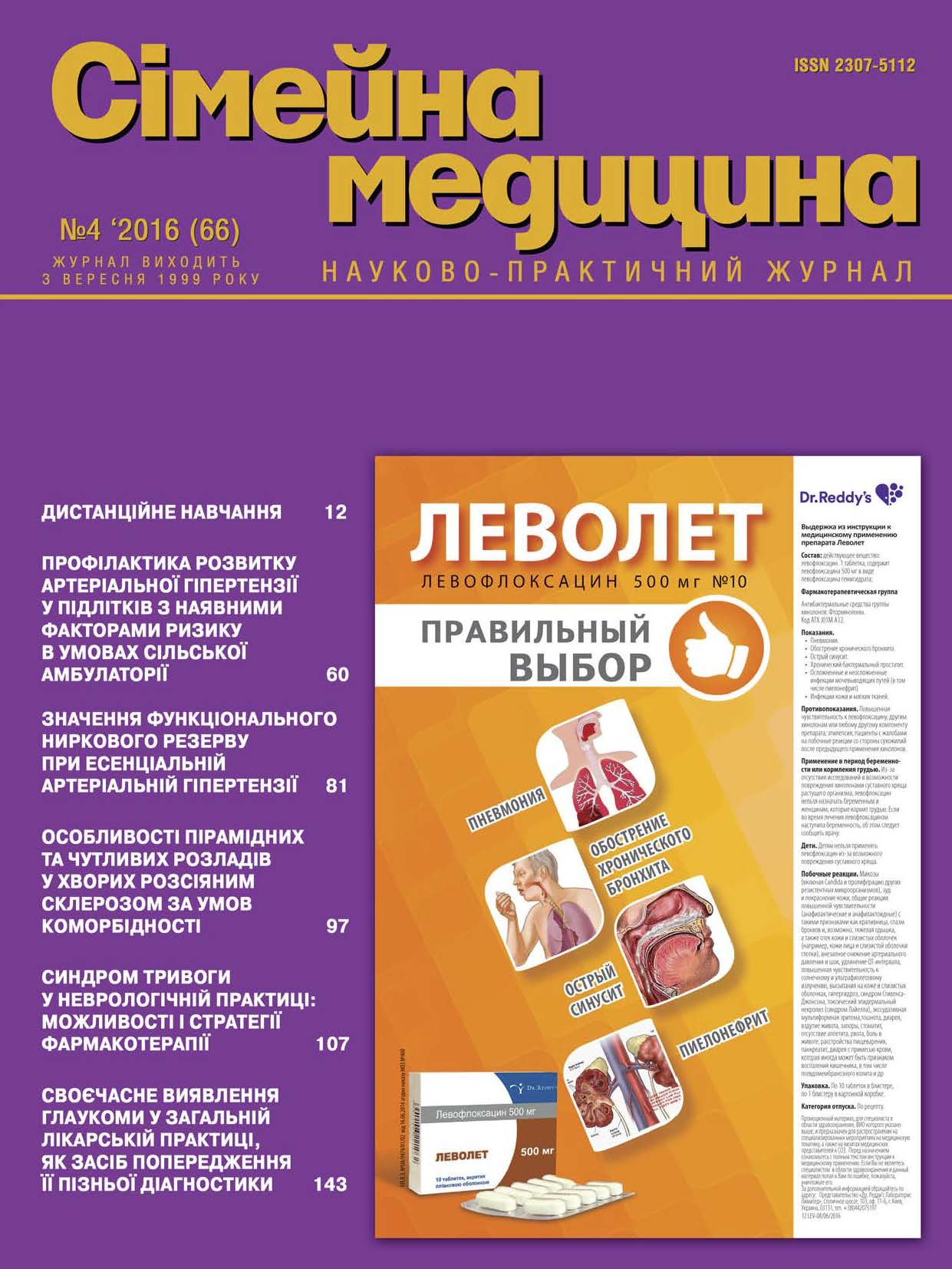The Significance of Renal Functional Reserve in Еssential Hypertension
##plugins.themes.bootstrap3.article.main##
Abstract
In the structure of causes of the end-stage chronic kidney disease is essential hypertension (EH) which takes the leading role. One of the pathogenic mechanisms of hypertensive nephropathy is a violation of intrarenal blood flow, which clinically manifesting with hyperfiltration.
The objective: of the frequency of subclinical renal damage of patients with stage I EAH by water and salt loading and comparing these data with the standard criteria of essential nephropathy with hypertension.
Patients and methods. The study involved 30 patients aged 27 to 59 years with diagnosed grade 1 essential hypertension who did not receive medical treatment and did not have the disease (lesions) of the kidneys. Mean albumin/creatin ratio of patients constituted 15,12±5,02 mg/g. According to the analysis of outpatient cards hypertension duration do not exceed during 5 years. All patients underwent 24-hour blood pressure monitoring and determining the method RFR water and salt load (under patent Ukraine 42,860) [9].
The results of daily monitoring of blood pressure (DMAT) were patients divided into two groups: the 1st group included patients who had been diagnosted the I step and I stage of EH, it comprised 22 patients (73.3%). Second group included patients who had been diagnosted the II stage of EH – 8 patients (26.7%).
Results. Subclinical kidney damage were found in 8 patients (26.7%) in determining the method of water-salt load. (RFR 10±2,01% in 8 patients (26.7%) 1st group and RFR 22,31±3,9% in 22 patients (73.3%) significant difference between groups (p<0.05). Among them, the state of hyperfiltration detected in 15 patients (50%) 281,55±40,66 ml/min per 1.73 m2. In eGFR 51,36±9,98 ml/min per 1.73 m2 had 6 people (20%), RFR was reduced and amounted to 11,02±6,65%.
This shows that when increasing the blood pressure, kidney begins to lose its physiological reserve and its clinically possible to trace the transition state of hyperfiltration in decreased GFR. In determining GFR formula CKD-EPI reliable differences between groups were found.
Conclusions. 1. Hypertension is an urgent problem and requires constant attention of the doctors of various specialties, complex problems that affect the incidence of kidney damage in the preclinical stage of hypertensive nephropathy.
2. The early hypertensive nephropathy criteria for the development of microalbuminuria may appear hyperfiltration and reduce renal functional reserve.
3. In EH patients with grade 1 hypertension, II stage, compared with patients with hypertension with I stage of kidney damage, were often observed and showed low RFR.
4. Using water-salt load for patients with EH and stages for the evaluation of kidney function can detect subclinical renal involvement, the development of microalbuminuria and reduced GFR.
##plugins.themes.bootstrap3.article.details##

This work is licensed under a Creative Commons Attribution 4.0 International License.
Authors retain the copyright and grant the journal the first publication of original scientific articles under the Creative Commons Attribution 4.0 International License, which allows others to distribute work with acknowledgment of authorship and first publication in this journal.
References
Арутюнов Г.П., Оганезова Л.Г. Кафедра терапии Московского факультета ГОУ ВПО РГМУ Росздрава. Проблема гиперфильтрации в клинической практике. Клиническая нефрология. – 2009, № 1.
Вельков В.В. Диабетическая нефропатия в трех измерениях: гиперфильтрация, альбумин, креатинин // Современная лаборатория. – 2013. – Т. 3. № 16. – С. 18-36.
Гоженко А.І. Функціональний нирковий резерв: фізіологічне значення функціонального ниркового резерву та обґрунтування методики його визначення / Гоженко А.І., Кравчук А.В., Сірман В.М., Никитенко О.П., Романів Л.В. // Почки. – 2015. – Т. 4, № 14. – С. 7-11.
Кутирина И.М., Рогов В.А., Шестакова М.В. и др. Гиперфильтрация как фактор прогрессирования хронических заболеваний почек // Тер. Арх. – 1992. – № 6. – С. 10-15.
Лутай М.Н. Национальная программа борьбы с артериальной гипертензией. Итог четырехлетней работы / М.Н. Лутай // Здоров’я України. – 2003. – № 74. – С. 3-4.
Романів Л.В. Роль нирок у регуляції водно-сольового обміну / Л.В. Романів, А.В. Хамініч // Вісник проблем біології і медицини. – 2008. – Вип. 3. – С. 8-14.
Гоженко А.І. Пат. № 42860 Україна, МПК (2009) А61В 5/20. Спосіб визначення функціонального ниркового резерву / Гоженко А.І., Хамініч А.В., Лебедєва Т.Л.
Настанова та клінічний протокол надання медичної допомоги «Артеріальна гіпертензія», затверджений Наказом МОЗ № 384 від 24.05.2012. – К., 2012. – 21-23 с.
Хамініч А.В. Функціональний стан нирок в умовах спонтанного та індукованого діурезу у нефрологічно здорових осіб / А.В. Хамініч, А.І. Гоженко, Л.В. Романів, Т.Л. Лєбєдєва, В.А. Жуков // Вісник морської медицини. – 2008. – № 3–4. – С. 70-75.
Abellán J, Leal M, Hernández-Menárguez F, Garcнa-Galbis JA, Martнnez-Pastor A, de Vinuesa SG, Luсo J. Efficacy of moxonidine in the treatment of hypertension in obese, non-controlled hypertensive patients.
ESH/ESC Guidelines for the management of arterial hypertension journal of hypertension 2013;31:(7). – P. 1281-1357.
Kidney Disease: Improving Global Outcomes (KDIGO) CKD Work Group. KDIGO 2012 Clinical Practice Guideline for the Evaluation and Management of Chronic Kidney Disease. Kidney international, Suppl.2013;3:1-150.
Paolo Palatini, Lucio Mos, Pierferruccio Ballerini, Adriano Mazzer, Francesca Saladini, Alessandra Bortolazzi, Susanna Cozzio, Edoardo Casiglia, and on behalf of the HARVEST Investigators. Relationship between GFR and Albuminuria in Stage 1 Hypertension. Clin J Am Soc Nephrol. 2013 Jan 7; 8(1):59-66.





